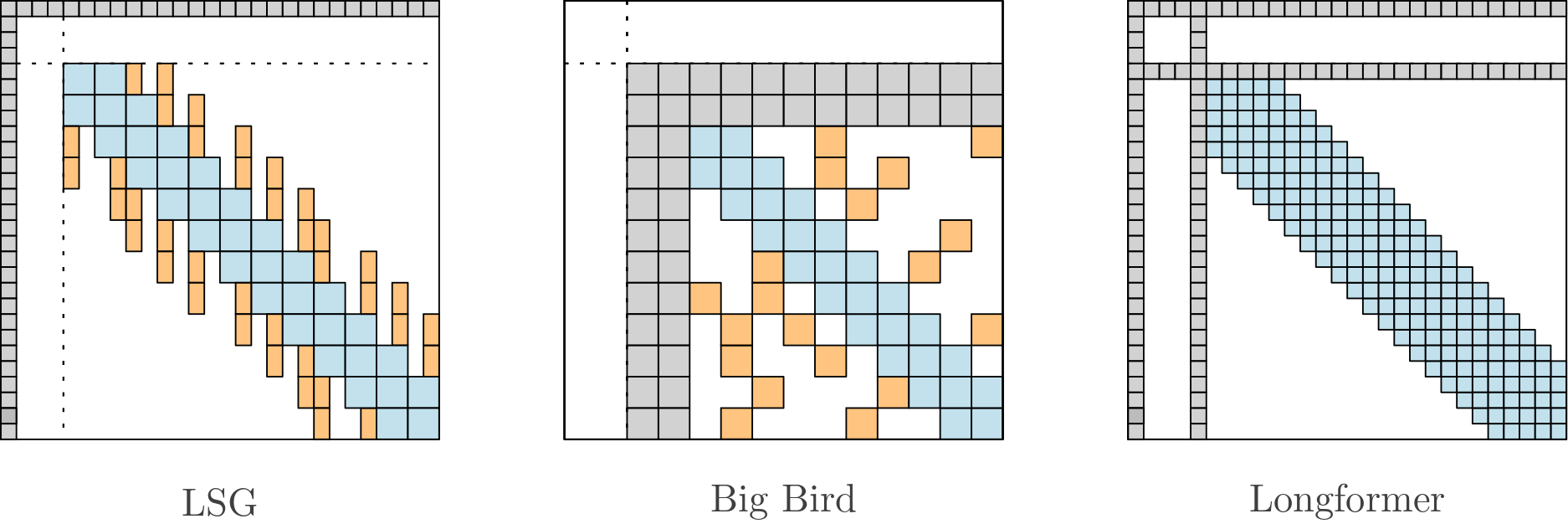LSG model
Transformers >= 4.36.1
This model relies on a custom modeling file, you need to add trust_remote_code=True
See #13467
LSG ArXiv paper.
Github/conversion script is available at this link.
This model is adapted from AlBERT-base-v2 without additional pretraining. It uses the same number of parameters/layers and the same tokenizer.
This model can handle long sequences but faster and more efficiently than Longformer (LED) or BigBird (Pegasus) from the hub and relies on Local + Sparse + Global attention (LSG).
The model requires sequences whose length is a multiple of the block size. The model is "adaptive" and automatically pads the sequences if needed (adaptive=True in config). It is however recommended, thanks to the tokenizer, to truncate the inputs (truncation=True) and optionally to pad with a multiple of the block size (pad_to_multiple_of=...).
Implemented in PyTorch.
Usage
The model relies on a custom modeling file, you need to add trust_remote_code=True to use it.
from transformers import AutoModel, AutoTokenizer
model = AutoModel.from_pretrained("ccdv/lsg-albert-base-v2-4096", trust_remote_code=True)
tokenizer = AutoTokenizer.from_pretrained("ccdv/lsg-albert-base-v2-4096")
Parameters
You can change various parameters like :
- the number of global tokens (num_global_tokens=1)
- local block size (block_size=128)
- sparse block size (sparse_block_size=128)
- sparsity factor (sparsity_factor=2)
- mask_first_token (mask first token since it is redundant with the first global token)
- see config.json file
Default parameters work well in practice. If you are short on memory, reduce block sizes, increase sparsity factor and remove dropout in the attention score matrix.
from transformers import AutoModel
model = AutoModel.from_pretrained("ccdv/lsg-albert-base-v2-4096",
trust_remote_code=True,
num_global_tokens=16,
block_size=64,
sparse_block_size=64,
attention_probs_dropout_prob=0.0
sparsity_factor=4,
sparsity_type="none",
mask_first_token=True
)
Sparse selection type
There are 6 different sparse selection patterns. The best type is task dependent.
If sparse_block_size=0 or sparsity_type="none", only local attention is considered.
Note that for sequences with length < 2*block_size, the type has no effect.
sparsity_type="bos_pooling"(new)- weighted average pooling using the BOS token
- Works best in general, especially with a rather large sparsity_factor (8, 16, 32)
- Additional parameters:
- None
sparsity_type="norm", select highest norm tokens- Works best for a small sparsity_factor (2 to 4)
- Additional parameters:
- None
sparsity_type="pooling", use average pooling to merge tokens- Works best for a small sparsity_factor (2 to 4)
- Additional parameters:
- None
sparsity_type="lsh", use the LSH algorithm to cluster similar tokens- Works best for a large sparsity_factor (4+)
- LSH relies on random projections, thus inference may differ slightly with different seeds
- Additional parameters:
- lsg_num_pre_rounds=1, pre merge tokens n times before computing centroids
sparsity_type="stride", use a striding mecanism per head- Each head will use different tokens strided by sparsify_factor
- Not recommended if sparsify_factor > num_heads
sparsity_type="block_stride", use a striding mecanism per head- Each head will use block of tokens strided by sparsify_factor
- Not recommended if sparsify_factor > num_heads
Tasks
Seq2Seq example for summarization:
from transformers import AutoModelForSeq2SeqLM, AutoTokenizer
model = AutoModelForSeq2SeqLM.from_pretrained("ccdv/lsg-albert-base-v2-4096",
trust_remote_code=True,
pass_global_tokens_to_decoder=True, # Pass encoder global tokens to decoder
)
tokenizer = AutoTokenizer.from_pretrained("ccdv/lsg-albert-base-v2-4096")
SENTENCE = "This is a test sequence to test the model. " * 300
token_ids = tokenizer(
SENTENCE,
return_tensors="pt",
padding="max_length", # Optional but recommended
truncation=True # Optional but recommended
)
output = model(**token_ids)
Classification example:
from transformers import AutoModelForSequenceClassification, AutoTokenizer
model = AutoModelForSequenceClassification.from_pretrained("ccdv/lsg-albert-base-v2-4096",
trust_remote_code=True,
pass_global_tokens_to_decoder=True, # Pass encoder global tokens to decoder
)
tokenizer = AutoTokenizer.from_pretrained("ccdv/lsg-albert-base-v2-4096")
SENTENCE = "This is a test sequence to test the model. " * 300
token_ids = tokenizer(
SENTENCE,
return_tensors="pt",
#pad_to_multiple_of=... # Optional
truncation=True
)
output = model(**token_ids)
> SequenceClassifierOutput(loss=None, logits=tensor([[-0.3051, -0.1762]], grad_fn=<AddmmBackward>), hidden_states=None, attentions=None)
AlBERT
@article{DBLP:journals/corr/abs-1909-11942,
author = {Zhenzhong Lan and
Mingda Chen and
Sebastian Goodman and
Kevin Gimpel and
Piyush Sharma and
Radu Soricut},
title = {{ALBERT:} {A} Lite {BERT} for Self-supervised Learning of Language
Representations},
journal = {CoRR},
volume = {abs/1909.11942},
year = {2019},
url = {http://arxiv.org/abs/1909.11942},
archivePrefix = {arXiv},
eprint = {1909.11942},
timestamp = {Fri, 27 Sep 2019 13:04:21 +0200},
biburl = {https://dblp.org/rec/journals/corr/abs-1909-11942.bib},
bibsource = {dblp computer science bibliography, https://dblp.org}
}
- Downloads last month
- 13
